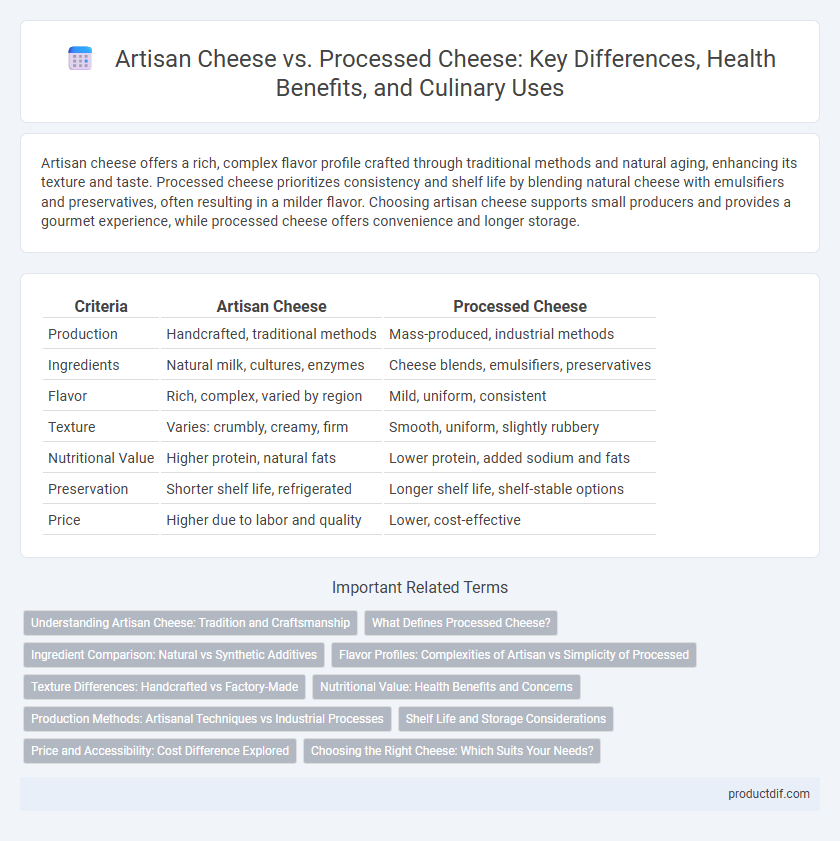Artisan cheese offers a rich, complex flavor profile crafted through traditional methods and natural aging, enhancing its texture and taste. Processed cheese prioritizes consistency and shelf life by blending natural cheese with emulsifiers and preservatives, often resulting in a milder flavor. Choosing artisan cheese supports small producers and provides a gourmet experience, while processed cheese offers convenience and longer storage.
Table of Comparison
| Criteria | Artisan Cheese | Processed Cheese |
|---|---|---|
| Production | Handcrafted, traditional methods | Mass-produced, industrial methods |
| Ingredients | Natural milk, cultures, enzymes | Cheese blends, emulsifiers, preservatives |
| Flavor | Rich, complex, varied by region | Mild, uniform, consistent |
| Texture | Varies: crumbly, creamy, firm | Smooth, uniform, slightly rubbery |
| Nutritional Value | Higher protein, natural fats | Lower protein, added sodium and fats |
| Preservation | Shorter shelf life, refrigerated | Longer shelf life, shelf-stable options |
| Price | Higher due to labor and quality | Lower, cost-effective |
Understanding Artisan Cheese: Tradition and Craftsmanship
Artisan cheese embodies centuries-old traditions, crafted by skilled cheesemakers using natural milk and time-honored techniques that emphasize flavor complexity and texture. This cheese undergoes minimal processing, aging naturally to develop unique profiles influenced by local terroir and milk quality. By contrast, processed cheese prioritizes uniformity and shelf life through blending, pasteurization, and additives, lacking the nuanced craftsmanship integral to artisan varieties.
What Defines Processed Cheese?
Processed cheese is defined by its creation through the blending of natural cheese with emulsifiers, stabilizers, and other additives to achieve a consistent texture and extended shelf life. Unlike artisan cheese, which undergoes traditional aging and natural fermentation processes, processed cheese is designed for uniform meltability and longer preservation. This type of cheese often contains ingredients such as milk solids, whey, and preservatives that distinguish it from the pure, handcrafted qualities of artisan varieties.
Ingredient Comparison: Natural vs Synthetic Additives
Artisan cheese is crafted primarily from natural ingredients such as milk, rennet, and live cultures, preserving its authentic flavors and textures. Processed cheese contains synthetic additives, emulsifiers, and preservatives to enhance shelf life and meltability, often at the expense of taste complexity. The contrast between natural ingredients in artisan cheese and synthetic additives in processed cheese significantly impacts nutritional value, flavor profiles, and consumer preference.
Flavor Profiles: Complexities of Artisan vs Simplicity of Processed
Artisan cheese offers rich, nuanced flavor profiles derived from traditional methods and diverse milk sources, resulting in unique textures and aromatic complexities. Processed cheese provides a consistent, mild taste with a smooth, creamy texture designed for widespread appeal and easy melting. This contrast highlights artisan varieties as gourmet choices while processed cheese serves practical, everyday culinary needs.
Texture Differences: Handcrafted vs Factory-Made
Artisan cheese features a complex, varied texture due to traditional handcrafting methods that encourage natural aging and microbial diversity, resulting in a creamier, often crumbly consistency. Processed cheese, produced in factories, typically has a uniform, smooth texture achieved through emulsifiers and heat treatment, designed for consistent meltability and shelf stability. The handcrafted approach preserves unique texture nuances, while processed cheese prioritizes convenience and mass production.
Nutritional Value: Health Benefits and Concerns
Artisan cheese offers higher nutritional value, rich in natural probiotics, vitamins A, B12, calcium, and beneficial fatty acids that support gut health and bone strength. Processed cheese often contains additives, emulsifiers, and higher sodium levels, which may lead to health concerns like increased cholesterol and hypertension risk. Choosing artisan cheese supports nutrient density and better digestion, while processed cheese provides convenience at the cost of reduced nutritional benefits.
Production Methods: Artisanal Techniques vs Industrial Processes
Artisan cheese is crafted using traditional artisanal techniques that emphasize natural fermentation, hand-milking, and aging processes to develop complex flavors and textures, often supported by local terroir. In contrast, processed cheese is produced through industrial processes that blend various cheese types with emulsifiers, stabilizers, and preservatives to ensure consistency, extended shelf life, and mass production efficiency. The artisanal method prioritizes quality and uniqueness, while processed cheese favors scalability and uniformity.
Shelf Life and Storage Considerations
Artisan cheese typically has a shorter shelf life due to its natural aging process and lack of preservatives, requiring refrigeration and careful storage in a breathable environment to maintain flavor and texture. Processed cheese contains additives and emulsifiers that extend shelf life and allow for storage at room temperature before opening, though refrigeration after opening is recommended to prevent spoilage. Proper storage significantly impacts the longevity and quality of both cheese types, with artisan varieties benefiting from controlled humidity and processed cheeses favoring sealed packaging.
Price and Accessibility: Cost Difference Explored
Artisan cheese typically commands a higher price due to traditional production methods and premium ingredients, reflecting its handcrafted quality and unique flavors. Processed cheese is more affordable and widely accessible, produced on a larger scale with added preservatives to extend shelf life. Consumers often balance the cost difference with preferences for taste, texture, and availability in supermarkets versus specialty shops.
Choosing the Right Cheese: Which Suits Your Needs?
Artisan cheese offers rich flavors and diverse textures crafted through traditional methods, ideal for gourmet dishes and savoring authentic taste profiles. Processed cheese provides uniform consistency, longer shelf life, and meltability, making it practical for sandwiches, fast food, and mass production. Selecting between artisan and processed cheese depends on your culinary needs, preference for natural ingredients, and desired cheese functionality.
Artisan cheese vs Processed cheese Infographic

 productdif.com
productdif.com